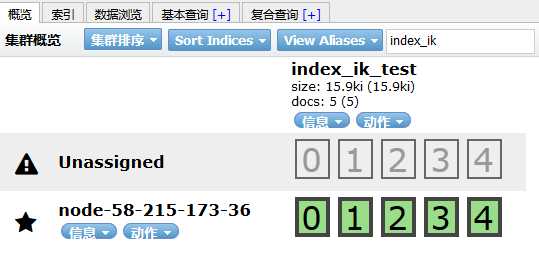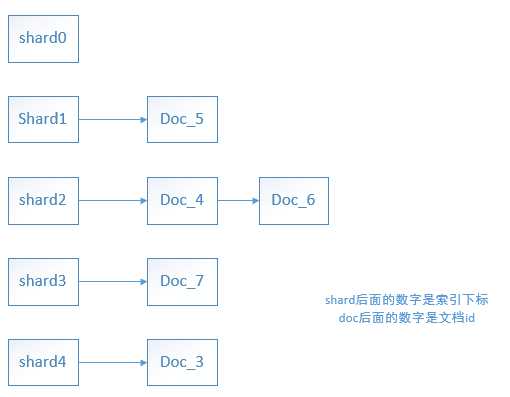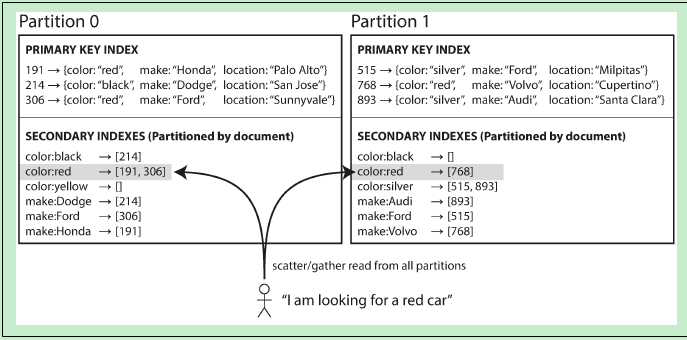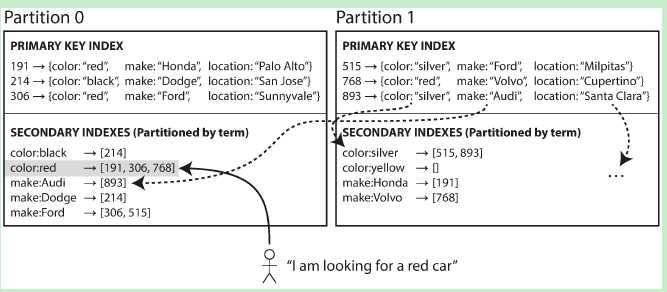标签:key 默认 cas block only setting name 分割 冲突
按照es-ik分析器安装了ik分词器。然后创建了一个索引用来演示,创建索引:PUT /index_ik_test。索引的结构如下:
GET index_ik_test/_mapping
{
"index_ik_test": {
"mappings": {
"fulltext": {
"properties": {
"content": {
"type": "text",
"analyzer": "ik_max_word"
},
"nick": {
"type": "text",
"fields": {
"keyword": {
"type": "keyword",
"ignore_above": 256
}
}
}
}
}
}
}
}实验环境为:单台的ElasticSearch6.3.2版本。索引配置如下:
GET index_ik_test/_settings
{
"index_ik_test": {
"settings": {
"index": {
"creation_date": "1533383757075",
"number_of_shards": "5",
"number_of_replicas": "1",
"uuid": "JajsYmAIT0-uhm-L5xKbeA",
"version": {
"created": "6030299"
},
"provided_name": "index_ik_test"
}
}
}
}由此可知,ElasticSearch创建索引时,默认为5个primary shard,每个primary shard 一个replica。
在Kibana的Monitoring界面查看:有5个primary shard。其中有5个尚未分配的副本:

为什么有5个尚未分配的副本呢?因为是单节点的ElasticSearch,索引 index_ik_test 的每个primary shard 都有一个副本,而primary shard 与副本 不能在同一台机器上,由于一共有5个primary shard,故存在着5个尚未分配的副本。
该索引一共存储着5篇文档,
GET index_ik_test/fulltext/_search
{
"query": {
"match_all": {}
}
}查询文档如下:

这5篇文档中有三篇文档(文档id为 5、4、3)包含了 词 “中国”。由于采用的ik_max_word分词,因此“其中国家投资了500万”,是包含“中国”这个词的。
每个分片中存储的文档如下:

其中,shard2代表 分片:[index_ik_test][2] ,shard2上存储着 doc id为 4和6 的两篇文档。shard1 代表分片:[index_ik_test][1],shard1上存储着 文档id为 5 的一篇文档。其它分片存储的文档以此类推。(是不是很奇怪我是怎么知道每个分片上存储具体哪篇文档的?这是因为:在这个演示环境中,文档数量少,我是通过不同的查询词(比如 通过 query explian "我们",就能知道 doc_6 存储在shard2上了)进行explian查询测试得到的。哈哈,知道这个主要是为了后面的 idf 计算分析)
下面以词 "中国" 为例 来解释:query explian。执行:
GET index_ik_test/fulltext/_search
{
"explain": true,
"query": {
"match": {
"content": "中国"
}
}
}下面从该命令的执行结果详细分析:
{
"took": 1,
"timed_out": false,
"_shards": {
"total": 5,
"successful": 5,
"skipped": 0,
"failed": 0
},
"hits": {
"total": 3,
"max_score": 0.5480699,
这表明,查询请求 scatter 到了所有的 shard (5个shard),其中有3个shard “命中了” 查询词 “中国”。这3个shard如下:
"_shard": "[index_ik_test][2]"
"_shard": "[index_ik_test][1]"
"_shard": "[index_ik_test][4]"每个shard都会计算一个score,这3个shard中,得分最大的分片是shard2 [index_ik_test][2],它的score是:0.5480699。因此,shard2上的返回结果排在了最前面,只是这里有个小疑问,为什么score返回结果是取最大值(max_score)?
[index_ik_test][2]: "_shard": "[index_ik_test][2]",
"_node": "7MyDkEDrRj2RPHCPoaWveQ",
"_index": "index_ik_test",
"_type": "fulltext",
"_id": "4",
"_score": 0.5480699,
"_source": {
"content": "中国驻洛杉矶领事馆遭亚裔男子枪击 嫌犯已自首"
},文档id 4 存储在shard2 上。该文档针对查询字符串 “中国” 计算出来的得分是0.5480699。具体的计算细节如下:
"_explanation": {
"value": 0.5480699,
"description": "weight(content:中国 in 0) [PerFieldSimilarity], result of:",
"details": [
{
"value": 0.5480699,
"description": "score(doc=0,freq=1.0 = termFreq=1.0\n), product of:",
"details": [
{
"value": 0.6931472,
"description": "idf, computed as log(1 + (docCount - docFreq + 0.5) / (docFreq + 0.5)) from:",
"details": [
{
"value": 1,
"description": "docFreq",
"details": []
},
{
"value": 2,
"description": "docCount",
"details": []
}
]
},
{
"value": 0.7906977,
"description": "tfNorm, computed as (freq * (k1 + 1)) / (freq + k1 * (1 - b + b * fieldLength / avgFieldLength)) from:",
"details": [
{
"value": 1,
"description": "termFreq=1.0",
"details": []
},
{
"value": 1.2,
"description": "parameter k1",
"details": []
},
{
"value": 0.75,
"description": "parameter b",
"details": []
},
{
"value": 8.5,
"description": "avgFieldLength",
"details": []
},
{
"value": 14,
"description": "fieldLength",
"details": []
}
]
}
]
}
]
}0.5480699 由idf 乘以 tfNorm 计算得到。其中 idf=0.6931472,tfNorm=0.7906977
idf
idf由公式 log(1 + (docCount - docFreq + 0.5) / (docFreq + 0.5))计算得出。其中,docFreq=1,docCount=2
不信的话就亲自动手算算看。^~^
我这里有疑问的地方是:这里的 idf 计算公式与官网提到的计算公式有一点不一样:

docFreq=1表示:"中国"这个词 只在 一篇文档中出现了。
https://lucene.apache.org/core/7_4_0/core/org/apache/lucene/search/similarities/TFIDFSimilarity.html
docFreq (the number of documents in which the term t appears)
docFreq- the number of documents which contain the term
docCount- the total number of documents in the collection
dcoCount=2表示:分片[index_ik_test][2] 里面一共存储了2篇文档(即doc_4 和 doc_6)。
tfNorm
tfNorm由公式(freq * (k1 + 1)) / (freq + k1 * (1 - b + b * fieldLength / avgFieldLength))计算。
freq ,即termFreq,应该是:term 在该分片下的所有文档中出现的频率。在这里,“中国” 在 shard2 的两篇文档中,只出现过一次
k1 ,这个参数很有意思,默认值为1.2,是用来 平衡 词频termFreq 对评分的影响。在传统的TF评分计算过程中,termFreq越大,计算出来的评分就越大。但是当termFreq大到一定程度时,一般是那种常用词(或者叫stop words),而这种词会干扰文档的评分,因此引入参数 k1 惩罚 termFreq 对评分的影响。要想了解更多,可参考这篇文章:bm25-the-next-generation-of-lucene-relevation。这里也说明,ElasticSearch6.3.2中已经采用了BM25算法作为相关性得分计算公式了。
b,从tfNorm公式可看出:用来调节字段长度对评分的影响。
avgFieldLength 值为8.5。为什么是8.5呢?
在我们的示例中,shard2 [index_ik_test][2]中一共存储了2篇文档,一篇是doc_4,doc_6的content字段就是"中国驻洛杉矶领事馆遭亚裔男子枪击 嫌犯已自首"。另一篇是doc_6,它的content字段是"我们的国家"。
对doc_6的content字段进行分析:
GET index_ik_test/_analyze
{
"text": ["我们的国家"],
"analyzer": "ik_max_word"
}
得到的各个 token 如下:
我们、的、国家
一共3个token在下面的第五点fieldLength中,对doc_4的content字段进行分析得到 14个token。
因此,avgFieldLength = (14+3)/2=8.5。14 是doc_4 content字段分词之后的token数目;3是doc_6 content字段分词之后的token数目;2 代表:有两篇文档。
由此可知:avgFieldLength 应该是:shard2分片中 content字段下所有内容 经过 ik_max_word 分词后的token 总数 除以 shard2里面的文档数目。
fieldLength,长度为14。这个是doc_4 “中国驻洛杉矶领事馆遭亚裔男子枪击 嫌犯已自首” ik_max_word分词之后的长度。因此,fieldLength指的是 查询字段(content字段) 被分析(创建索引时指定了 ik_max_word分析器) 之后 的长度。
GET index_ik_test/_analyze
{
"text": ["中国驻洛杉矶领事馆遭亚裔男子枪击 嫌犯已自首"],
"analyzer": "ik_max_word"
}
得到的各个token如下:
中国、驻、洛杉矶、领事馆、领事、馆、遭、亚裔、男子、子枪、枪击、嫌犯、已、自首
一共 14 个token各个参数的值以及计算过程如下:
freq=1.0
k1=1.2
b=0.75
avgFieldLength=8.5
fieldLength=14
(freq*(k1+1))/(freq+k1*(1-b+b*fieldLength/avgFieldLength))
0.7906976744186047
现在,针对shard2,我们已经详细分析了 tfNorm 和 idf 这两个参数的计算结果。最终,shard2上的查询得分为 tfNorm*idf=0.7906977*0.6931472=0.5480699。另外两个命中 “中国” 的分片的得分计算也类似,就不说了。
由此可看出:ElasticSearch中 tf-idf 的值 是根据单个分片来计算的,也即:以单个的shard为单位来计算 score,更具体地说:当我们讲 某 term 一共在 文档集合中出现了多少次?这个文档集合指的是:单个分片上存储的所有文档。为什么是统计单个分片上的文档/term 数量呢?这个就要从ElasticSearch的索引方式说起了。这里就简单地提一下,毕竟这不是本文的重点。
ElasticSearch中有两个不同Level的索引,一个是:文档到分片 这个级别的索引,它讲的是 数据的分布方式,即决定把哪篇文档存储在哪个分片上,这是通过hash文档ID的方式来实现的。采用hash方式的好处是,ElasticSearch不需要维护文档的位置信息(boundary),文档能够均匀地分布在各个shard上。ElasticSearch采用的哈希函数是:murmur3。
另一个级别的索引是:term 到 文档的索引,俗称倒排索引,又称为:Secondary index。因为我们的查询需求并不是:给定一个docId,返回这个docId所代表的文档内容。我们的查询需求是:给定一个 查询关键词,找出哪些docId 包含了这个 查询关键词。因此,要完成这个查询,第一步是要知道 有哪些docId 包含了 查询关键词;第二步则是:根据docId,拿到相应的文档内容。
当文档的数量很多很多时,一台机器或者说一个shard都存储不下这个倒排索引了,因此需要对倒排索引进行分割(partition)。一种分割方式是:Secondary index by Document,另一种是:Secondary index by Term。

? 这种Secondary Index的分布方式(或者叫数据分布方式,这里的数据当然是倒排索引数据了)是针对每个Partition上的文档建立一个独立的Secondary Index(倒排索引)。这种索引方式的好处是:当写入/更新文档时,只涉及到该Partition中的倒排索引,而不会修改其他的Partition中的倒排索引内容。
更具体地,以ElasticSearch举例,因为ElasticSearch就是采用Secondary index by Document。当创建索引时,是默认5个Primary shard,每个Primary shard 一个副本(replica)。Primary shard 就相当于这里的Partition概念。当向ElasticSearch的索引中写入文档时,写请求是请求给某个Primary shard,然后在该Primary shard上构建 倒排索引(posting list),而并不需要修改 其他4个Primary shard 中的倒排索引内容。
each partition is completely separate: each partition maintains its own secondary indexes, covering only the documents in that partition. It doesn’t care what data is stored in other partitions.
? 因此,查询的时候,需要将查询请求发送到每一个partition(shard)

? 这种Secondary index的分布方式 是按”范围“ 来进行分布,关于数据的分布方式,可参考:[分布式系统原理介绍。比如说,对于 color 这个字段,颜色有 black、red、silver……文档中 颜色范围首字母为 [a-r] 的那些docId 存储在 Partition0 分片上。而所有 颜色范围首字母 [s-z] 的docId,则存储在Partition1分片上。 采用这种分布方式的倒排索引,一篇文档中的不同字段 可能会在 多个Partition的字段中被索引。比如,文档893 的color 字段的内容是 silver,它在Partition1中被索引了;而文档893的make字段内容是Audi,它在Partition0中被索引了。这种索引方式的缺点显而易见:当更新/插入一篇文档时,有可能需要更新多个Partition中的倒排索引内容。 因此,查询的时候,可以只将查询请求发送到某个特定的partition(shard)。
以上内容,全是自己的理解。可能会有很多不严谨的地方。
参考文献:
最后,放一份完整的explian 查询分析 返回内容:
{ "took": 1, "timed_out": false, "_shards": { "total": 5, "successful": 5, "skipped": 0, "failed": 0 }, "hits": { "total": 3, "max_score": 0.5480699, "hits": [ { "_shard": "[index_ik_test][2]", "_node": "7MyDkEDrRj2RPHCPoaWveQ", "_index": "index_ik_test", "_type": "fulltext", "_id": "4", "_score": 0.5480699, "_source": { "content": "中国驻洛杉矶领事馆遭亚裔男子枪击 嫌犯已自首" }, "_explanation": { "value": 0.5480699, "description": "weight(content:中国 in 0) [PerFieldSimilarity], result of:", "details": [ { "value": 0.5480699, "description": "score(doc=0,freq=1.0 = termFreq=1.0\n), product of:", "details": [ { "value": 0.6931472, "description": "idf, computed as log(1 + (docCount - docFreq + 0.5) / (docFreq + 0.5)) from:", "details": [ { "value": 1, "description": "docFreq", "details": [] }, { "value": 2, "description": "docCount", "details": [] } ] }, { "value": 0.7906977, "description": "tfNorm, computed as (freq * (k1 + 1)) / (freq + k1 * (1 - b + b * fieldLength / avgFieldLength)) from:", "details": [ { "value": 1, "description": "termFreq=1.0", "details": [] }, { "value": 1.2, "description": "parameter k1", "details": [] }, { "value": 0.75, "description": "parameter b", "details": [] }, { "value": 8.5, "description": "avgFieldLength", "details": [] }, { "value": 14, "description": "fieldLength", "details": [] } ] } ] } ] } }, { "_shard": "[index_ik_test][1]", "_node": "7MyDkEDrRj2RPHCPoaWveQ", "_index": "index_ik_test", "_type": "fulltext", "_id": "5", "_score": 0.2876821, "_source": { "content": "其中国家投资了500万" }, "_explanation": { "value": 0.2876821, "description": "weight(content:中国 in 0) [PerFieldSimilarity], result of:", "details": [ { "value": 0.2876821, "description": "score(doc=0,freq=1.0 = termFreq=1.0\n), product of:", "details": [ { "value": 0.2876821, "description": "idf, computed as log(1 + (docCount - docFreq + 0.5) / (docFreq + 0.5)) from:", "details": [ { "value": 1, "description": "docFreq", "details": [] }, { "value": 1, "description": "docCount", "details": [] } ] }, { "value": 1, "description": "tfNorm, computed as (freq * (k1 + 1)) / (freq + k1 * (1 - b + b * fieldLength / avgFieldLength)) from:", "details": [ { "value": 1, "description": "termFreq=1.0", "details": [] }, { "value": 1.2, "description": "parameter k1", "details": [] }, { "value": 0.75, "description": "parameter b", "details": [] }, { "value": 7, "description": "avgFieldLength", "details": [] }, { "value": 7, "description": "fieldLength", "details": [] } ] } ] } ] } }, { "_shard": "[index_ik_test][4]", "_node": "7MyDkEDrRj2RPHCPoaWveQ", "_index": "index_ik_test", "_type": "fulltext", "_id": "3", "_score": 0.2876821, "_source": { "content": "中韩渔警冲突调查:韩警平均每天扣1艘中国渔船" }, "_explanation": { "value": 0.2876821, "description": "weight(content:中国 in 0) [PerFieldSimilarity], result of:", "details": [ { "value": 0.2876821, "description": "score(doc=0,freq=1.0 = termFreq=1.0\n), product of:", "details": [ { "value": 0.2876821, "description": "idf, computed as log(1 + (docCount - docFreq + 0.5) / (docFreq + 0.5)) from:", "details": [ { "value": 1, "description": "docFreq", "details": [] }, { "value": 1, "description": "docCount", "details": [] } ] }, { "value": 1, "description": "tfNorm, computed as (freq * (k1 + 1)) / (freq + k1 * (1 - b + b * fieldLength / avgFieldLength)) from:", "details": [ { "value": 1, "description": "termFreq=1.0", "details": [] }, { "value": 1.2, "description": "parameter k1", "details": [] }, { "value": 0.75, "description": "parameter b", "details": [] }, { "value": 14, "description": "avgFieldLength", "details": [] }, { "value": 14, "description": "fieldLength", "details": [] } ] } ] } ] } } ] } }
原文:https://www.cnblogs.com/hapjin/p/9677753.html
ElasticSearch评分分析 explian 解释和一些查询理解
标签:key 默认 cas block only setting name 分割 冲突
原文地址:https://www.cnblogs.com/hapjin/p/9677753.html